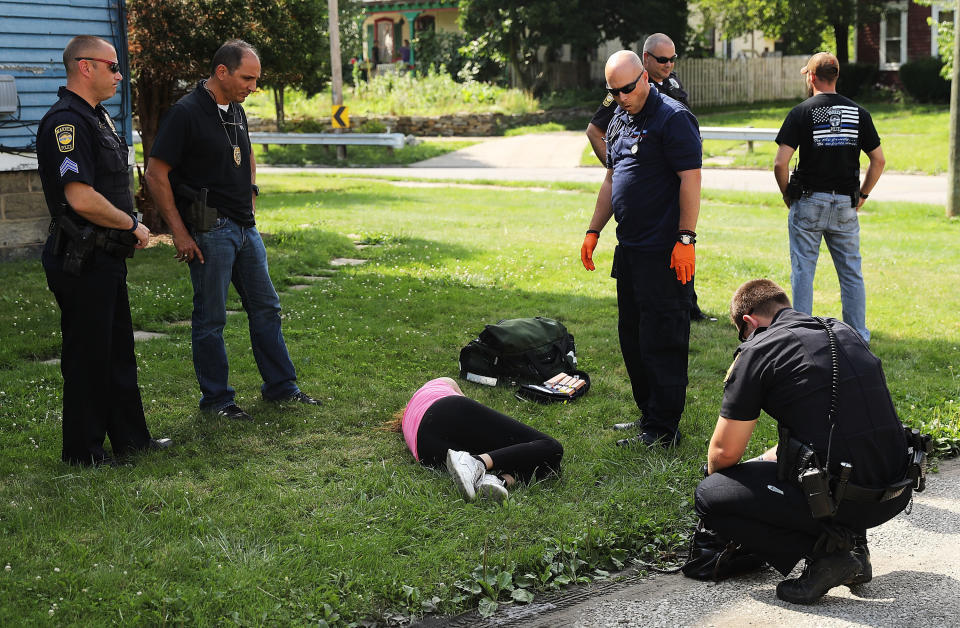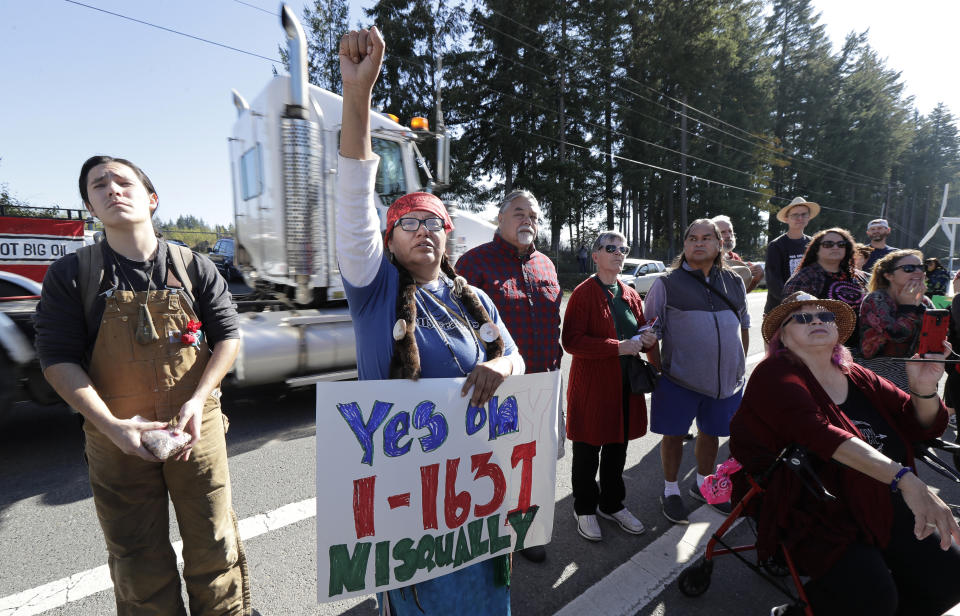The 2018 Midterms Were A Preview Of 2020's Policy Ideas
America is a big and complicated country in which elections rarely provide straightforward narratives. This month’s midterm elections were the simultaneous story of booming turnout and suppressed votes, a blue wave among women and a red shift among white men.
Ballot initiatives, the country’s laboratory for policy ideas, are even harder to transform into simple lessons or clear takeaways.
Voters in California, for example, banned animal cruelty and preserved a gas tax increase, while at the same time rejecting rent control and declining to cap the profits of dialysis companies. In Florida, voters approved stunningly progressive environmental and voting rights reforms alongside stunningly regressive taxation and tough-on-crime laws. Culture war battlegrounds ― including trans rights, gun control and police violence ― somehow became technocratic ballot measures that attracted little controversy and bipartisan support.
Direct democracy, in other words, is as complex and contradictory as the voters participating in it. This year’s ballot initiatives included wide-ranging reforms of criminal justice and voting rights, but also narrow efforts to cancel Daylight Savings Time, display the Ten Commandments on state property and ban water fluoridation.
They are also glimpses into the future. From content to messaging to funding, the 2018 midterms offer a preview of the policies — and the debates accompanying them — that are likely to dominate the 2020 campaign.

Big Ideas and Comprehensive Reforms
Ohio’s Issue 1 was going to overhaul the entire criminal justice system at once. First, the measure would have downgraded simple drug possession from a felony to a misdemeanor, capping the maximum penalty at six months of jail time. Second, it would have prevented courts from imposing prison sentences for probation violations. Third, the money it saved by reducing incarceration rates would have been poured into to drug treatment and rehabilitation programs.
It was stunningly ambitious, a constitutional amendment that would have transformed crime classification, sentencing and budgeting at the same time.
It was also, it turns out, too much for Ohio voters. The measure lost by nearly 30 percentage points.
“We didn’t have a blue wave here,” said Dennis Willard, the communications director for the Yes on Issue 1 campaign.
Still, the initiative offers a model that can be replicated in other states. And its loss provides a guide to the likely political opposition the proposals must overcome.
One of the reasons for Issue 1′s loss, Willard said, was the coalition of judges, prosecutors and sheriffs that formed against it. The initiatives drug sentencing provisions also became linked to the governor’s race, with entire segments of campaign debates dedicated to arguing over their implications for Ohio’s opioid epidemic. Both of these hurdles could be better anticipated and addressed by the campaigns for similar measures in other states.
Other defeated ballot initiatives also simply might fare better in other states. Maine, for example, proposed a tax on high earners to support universal home health care for the elderly and persons with disabilities. Nevada tried to end its state energy monopoly. Oklahoma attempted to dedicate its oil and gas revenues to a “stabilization fund” that would have been helped smooth out government spending in the next recession.
This blueprint ― if at first you don’t succeed, find a friendlier political environment ― has already blazed a path for dozens of other policy ideas over the years. Automatic voter registration, for example, began with a single campaign in Oregon. Minimum wage hikes and medical marijuana initiatives began as pilot ideas in a few cities, then expanded to entire states.
Turnout in 2020 is likely to be high, with the dynamics of 2018 even more amplified. As they look ahead, campaigners see perfect conditions for testing out big ideas and making second attempts at ones that have already been floated. Willard points out that only five states have reclassified drug possession as a misdemeanor since 2014. The attempt in Ohio has created a sense of urgency and possibility for other states to try the same idea again.
“It’s like moving a glacier,” Willard said. “The status quo is the status quo because it provides the greatest amount of comfort to people in power. So when you’re fighting to change it, you’re fighting the power structure.”
That’s why, he said, “You have to be willing to fight even if you know you might not win this time.”

More Aggressive Actions By Corporations
Corporations did not get everything they wanted in midterms, but they got pretty close.
Oil and gas companies spent $31 million to crush Washington state’s (second) attempt at a carbon tax. In California, dialysis companies poured $111 million into killing a measure that would have capped their profits at 15 percent. Efforts to protect groundwater from mining companies (Montana) and salmon from extractive drilling (Alaska) went down in flames following well-funded corporate campaigns. In perhaps the night’s most brazen victory, a Disney-led coalition of casino owners in Florida managed to make competition in their sector illegal altogether.
This, too, is a glimpse of things to come. While corporations often tout their charitable contributions and claim that they’re willing to work with lawmakers to address pollution, homelessness or health issues, their actions demonstrate that they will battle any effort to make these contributions mandatory.
Earlier this year in Seattle, Amazon and Starbucks led a successful campaign to repeal a tax on corporations that would have funded homeless services. In California, beverage companies retaliated against municipal soda taxes by sponsoring a ballot measure that would have required a two-thirds majority to raise any local taxes. If legislators hadn’t bargained to keep it off the ballot, the measure could have threatened local funding for libraries, parks, police and fire departments.
Together, the message these efforts sent is chilling: Corporations are willing to sacrifice the public interest for their own. And in the future, they’re only going to get more aggressive in doing so.

Voters Will (Sometimes) Support Initiatives That Cut Against Their Political Grain
One of the most notable wins for progressives in the midterms was Washington state’s “de-escalation” initiative. Under the new law, police officers will receive mandatory training on how to handle suspects non-violently and constructively engage with citizens suffering from mental illness. The measure, which takes its inspiration from the Black Lives Matter movement and was promoted by family members of police violence victims, also updates the law to make it easier to prosecute law enforcement officers for wrongful deaths.
But the most notable thing about the measure is not its structure or content. It’s that it passed with nearly 60 percent of the vote. Washington may have a reputation as a blue state, but it includes large rural and suburban populations. Many of the same voters who approved the police violence ballot measure also cast ballots to empower Republican legislators and decisively rejected a carbon tax.
So, in a country where 65 percent of conservative voters oppose the Black Lives Matter movement, how did a ballot measure so clearly inspired by it win bipartisan support?
Jack Sorensen, a spokesman for De-Escalate Washington, said the campaign deliberately tried to deliver a unifying message, highlighting the initiative’s support among police officers and its relevance in rural areas, where several police killings had taken place. When the Spokesman-Review, a newspaper in deep-red Eastern Washington, wrote an editorial opposing the measure, Sorensen worked with a retired local law enforcement official to write an Op-Ed supporting it.
The measure’s campaign also got lucky. Though the measure attracted opposition from some police unions and other law enforcement groups, none were bankrolled by billionaire donors or corporate interests. Unlike the state’s carbon tax initiative, voters received information about the police de-escalation measure that was proportionate to its impacts and accurate about its effects.
So it was with many of the other cross-aisle ballot initiatives that won on election night. Victorious medical marijuana and Medicaid expansion measures didn’t attract deep-pocketed opposition. Right-wing donors didn’t coalesce around voting-rights expansions. Florida’s felon re-enfranchisement initiative was supported by everyone from John Legend to the Koch brothers.
In a country where the channels for misinformation are proliferating and where a significant plurality believes in conspiracy theories, the greatest challenge for campaigners may be keeping their issues out of the headlines long enough for voters to make up their own minds.
Love HuffPost? Become a founding member of HuffPost Plus today.

Blue States Keep Expanding Voting Rights, Red States Keep Clamping Down
On the surface, 2018 was a great year for voting rights and election regulations. Florida re-enfranchised 1.5 million felons. Colorado, Missouri and Ohio restricted gerrymandering. Maryland adopted Election Day voter registration and Nevada made it automatic. Michigan approved a comprehensive voting-rights measure that included no-excuse absentee ballots.
Dig a little deeper, though, and you find the opposite trend holds true, too. Voter ID laws passed in North Carolina and Arkansas, backed by nearly 80 percent of voters in the latter state. North Dakota approved a symbolic measure stipulating that all voters must be citizens. Montana passed a bizarre ballot initiative restricting voters from handling each others’ ballots. All these measures are attempts to crack down on “voter fraud,” an idea that has captured the Republican imagination despite no evidence that it’s a systematic problem.
Between the platitudes of a voting-rights resurgence and a crackdown, what America appears to be experiencing is a bifurcation. In blue states, lawmakers are easing registration provisions and expanding the times and methods of voting. The first legislative project for the newly minted House Democratic majority may well be a nationwide law making it easier to vote.
But these policies are themselves a reaction to a countervailing and ongoing trend among GOP legislators. Between 2010 and 2018, 24 states passed restrictions on voting rights. The midterm elections were marred by long lines at voting machines, court battles and brazen attempts to disenfranchise the poor and people of color.
This divide is only going to get worse. Just as the current wave of voting rights legislation is a reaction to GOP attempts to curtail it, red states will likely resist, obstruct or find new workarounds to Democratic efforts to expand the franchise. While the Florida felon re-enfranchisement measure passed with broad support, other voting-rights expansions have lost in the face of nationally coordinated, well-funded opposition campaigns.
Democrats watched the midterm elections and heard a call to expand voting rights. Republicans, and their donors, may have heard a call to restrict them.
Which means that, even as the midterms showed Americans unified around a few core political principles, the states they live in will continue to drift apart.
This article originally appeared on HuffPost.


